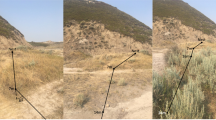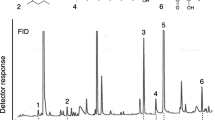Abstract
Foraging and territoriality in the ant Lasius neonigerinvolves a series of trails which channel foragers away from adjacent colonies. Experimental studies suggest that the trails are composed of colony-specific, persistent orientation components of hindgut material that accumulate on trails during foraging. A less durable component of the hindgut trail pheromone regulates recruitment. Foraging directionality and the use of a trail could be modified by experimentally arranging confrontations with conspecifics. The orientation of foragers is mediated by visual as well as chemical cues. Components of the foraging and territorial system of L. neonigerappear to include (1) a network of subnests which change in position seasonally within each polydomous nest; (2) a series of trails emanating from each subnest that adjusts search toward resource patches and away from aggressive, neighboring conspecifics; and (3) trail communication involving an ephemeral component of the hindgut trail pheromone that regulates the organization of cooperative prey retrieval and a more persistent component that serves as an orientation guide.
Similar content being viewed by others
References
Adams, E. A., and Traniello, J. F. A. (1981). Chemical interference competition byMonomorium minimum (Hymenoptera: Formicidae).Oecologia 51: 265–270.
Baroni-Urbani, C. (1979). Territoriality in social insects. In Hermann, H. R. (ed.),The Social Insects, Vol. 1, Academic Press, New York.
Batschelet, E. (1965). Statistical methods for the analysis of problems in animal orientation and certain biological rhythms, AIBS Monograph, Am. Inst. Biol. Sci., Washington, D.C.
Bernstein, R. A., and Gobbel, M. (1979). Partitioning of space in communities of ants.J. Anim. Ecol. 48: 931–942.
Davidson, D. (1977). Foraging ecology and community organization in desert seed-eating ants.Ecology 58: 725–737.
Hangartner, W. (1967). Spezifität und Inaktiverung des Spurpheromons vonLasius fuliginosus Latr. und Orientierung der Arbeiterinnen im Duftfeld.Z. vergl. Physiol. 57: 103–136.
Hangartner, W., Reichson, J., and Wilson, E. O. (1970). Orientation to nest material by the antPogonomyrmex badius (Latreille).Anim. Behav. 18: 331–334.
Hölldobler, B. (1974). Home range orientation and territoriality in harvesting ants.Proc. Natl. Acad. Sci. USA 71: 3274–3277.
Hölldobler, B. (1976). Recruitment behavior, home range orientation and territoriality in harvester ants,Pogonomyrmex.Behav. Ecol. Sociobiol. 1: 3–44.
Hölldobler, B. (1981). Foraging and spatiotemporal territories in the honey antMyrmecocystus mimicus Wheeler (Hymenoptera: Formicidae).Behav. Ecol. Sociobiol. 9: 301–314.
Hölldobler, B., and Lumsden, C. (1980). Territorial strategies in ants.Science 210: 732–739.
Hölldobler, B., and Möglich, M. (1980). The foraging system ofPheidole militicida (Hymenoptera: Formicidae).Insectes Soc. 27: 237–264.
Hölldobler, B., and Wilson, E. O. (1977). Colony-specific territorial pheromone in the African weaver antOecophylla longinoda (Latreille).Proc. Natl. Acad. Sci. USA 74: 2072–2075.
Huwyler, S., Grob, K., and Viscontini, M. (1975). The trail pheromone of the antLasius fuliginosus: Identification of six components.J. Insect Physiol. 21: 299–304.
Levings, S. C., and Franks, N. R. (1982). Patterns of nest dispersion in a tropical ground ant community.Ecology 62: 338–344.
Levings, S. C., and Traniello, J. F. A. (1981). Territoriality, nest dispersion and community structure in ants.Psyche 88: 265–319.
Oster, G., and Wilson, E. O. (1978).Caste and Ecology in the Social Insects, Princeton University Press, Princeton, N.J.
Regnier, F., Nieh, M., and Hölldobler, B. (1973). The volatile Dufour's gland component of the harvester antPogonomyrmex rugosus andP. barbatus.J. Insect Physiol. 19: 981–992.
Rissing, S. W., and Wheeler, J. (1976). Foraging responses ofVeromessor pergandei to changes in seed production.Pan-Pacif. Entomol. 52: 63–72.
Rockwood, L. L., and Hubbell, S. P. (1987). Host-plant selection, diet diversity, and optimal foraging in a tropical leafcutting ant.Oecologia 74: 55–61.
Rosengren, R. (1971). Route fidelity, visual memory, and recruitment behavior in foraging wood ants of the genusFormica (Hymenoptera: Formicidae).Acta Zool. Fenn. 133: 3–106.
Shepherd, J. D. (1982). Trunk trails and the searching strategy of a leaf-cutter ant,Ana colombica.Behav. Ecol. Socioblol. 11: 77–84.
Shepherd, J. D. (1985). Adjusting foraging effort to resources in adjacent colonies of the leafcutter ant,Atta colombica. Biotropica 17: 245–252.
Traniello, J. F. A. (1980a).Studies on the Behavioral Ecology of North Temperate Ants, Ph.D. thesis, Harvard University, Cambridge, Mass.
Traniello, J. F. A. (1980b). Colony specificity in the trail pheromone of an ant.Naturwissenschaften 67: 361.
Traniello, J. F. A. (1983). Social organization and foraging success inLasius neoniger (Hymenoptera: Formicidae): behavioral and ecological aspects of recruitment communication.Oecologia 59: 94–100.
Traniello, J. F. A. (1987). Comparative foraging ecology of north temperate ants: The role of worker size and cooperative foraging in prey selection.Insectes Soc. 34: 118–130.
Traniello, J. F. A., and Levings, S. C. (1986). Intra- and intercolony patterns of nest dispersion in the antLasius neoniger: Correlations with territoriality and foraging ecology.Oecologia 69: 413–419.
Wehner, R., Harkness, R. D., and Schmid-Hempel, P. (1983).Foraging Strategies in Individually Searching Ants Cataglyphis bicolor (Hymenoptera: Formicidae), Gustav Fischer Verlag, Stuttgart.
Wilson, E. O. (1955). A monographic revision of the ant genusLasius.Bull. Mus. Comp. Zool. Harvard 113: 1–201.
Author information
Authors and Affiliations
Rights and permissions
About this article
Cite this article
Traniello, J.F.A. Chemical trail systems, orientation, and territorial interactions in the antLasius neoniger . J Insect Behav 2, 339–354 (1989). https://doi.org/10.1007/BF01068060
Accepted:
Issue Date:
DOI: https://doi.org/10.1007/BF01068060




